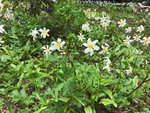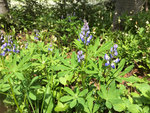

A walk through Mt. Rainier wildflowers can sure make a gardener humble. Nothing we can do will ever match the sight of a drift of avalanche lilies or a patch of paintbrush, alpine asters, rosy spirea and lupine.
There are bigger, more robust garden varieties of some of these flowers, but we will never have the majesty of Mt. Rainier’s magnificent setting, or the artless drifts and surprise delights of delicate tiger lilies in the foreground of the Nisqually glacier.
On Wednesday, a walk there set me off on a fantasy about what our yards and gardens would look like if they had been left in their natural state. What wildflowers, shrubs, vines and trees would we live among if we had only narrow foot paths from the road to our houses?
That fantasy was connected to a memory of a five-acre waterfront spread on Bainbridge Island, just down the road from where I once lived.
Although Bainbridge had been logged within decades of the first settlers’ arrival, that initial logging had been quite selective. Since then, these five acres had been owned by several generations of a Norwegian fishing family that lived in a nice white house. The land included majestic old fir, hemlock and cedar trees, huge big leaf maples, alder, cascara, willow, hazel, and native dogwoods. Beneath them were trillium and honeysuckle, sword ferns, elderberries, salmon berries and more. Lacy deciduous huckleberries crowned the enormous, rotting old-growth tree stumps left by those early loggers.
But when the last of the Norwegian fisherman died, the five acres were sold. Within weeks of their purchase by a couple from California, they were clear-cut.
Twenty-five years later, I returned to the island for its annual garden tour, and that same five acres was one of the showplace gardens. And it was truly a showplace – a McMansion surrounded by paved paths, thriving flower gardens and well-chosen shrubbery, a rock-lined human-made stream, and a large boathouse suitable for entertaining corporate clients.
I’ve carried the sadness about that garden – and a truth about gardening itrevealed to me – for a long time. So years later, when I read a news story about a local garden show, I was mortified but not surprised to read a quote from a gardener who described her place as having been “a blank slate” before she and her husband built a house and hired a landscape designer.
I know that every neighborhood – from the urban core to outermost exurbia – was once wild land, managed by the light hands of Salish people who never needed to scrape away native vegetation for the sake of Shasta daisies or zucchini. So it’s silly to disapprove of people wresting gardens out of the native natural world when all our neighborhoods have the same history.
But it’s not silly to think about it, or to imagine what our neighborhood looked like before the arrival of settlers. It helps us understand who and where we are in the long ark of both human and natural history in North America.
That’s not to say we shouldn’t love our gardens; it’s to say we’re likely to love them more deeply when we know more about their history as well as our own.
Tending a garden is an important doorway into a caring relationship between humans and the natural world. In this technologically driven and urbanizing world it’s a vital way to stay grounded.
Today’s world needs the gardens we cultivate. And we need to see mountain wildflowers once in a while.
Jill Severn writes from her home in Olympia, where she grows vegetables, flowers and a small flock of chickens. She loves conversation among gardeners. Start one by emailing her at jill@theJOLTnews.com
1 comment on this item Please log in to comment by clicking here
KarenM
Jill - I agree that seeing the flowers in their native habitat is amazing. We can create some of that natural feel in our own gardens and it helps the birds and insects when we do.
Native plants offer food for birds and flowers for bees. They also require less water and tending once they are established.
I have found my native plants at the Native Plant Salvage Foundation plant sales. In my garden I enjoy the hummingbirds coming to visit the red flowering currant each spring. Here are a few of the natives in my yard:
Sword fern, bush honeysuckle, oxalis, oregon grape, snowberry, vanilla leaf, inside-out-flower, salal, ocean spray, spirea, evergreen huckleberry. Many of these are happy under the Douglas fir and cedar trees.
If people are interested in learning about our native plants and gardening with them the Native Plant Society is a good place to start. They have local chapters.
Saturday, July 31, 2021 Report this